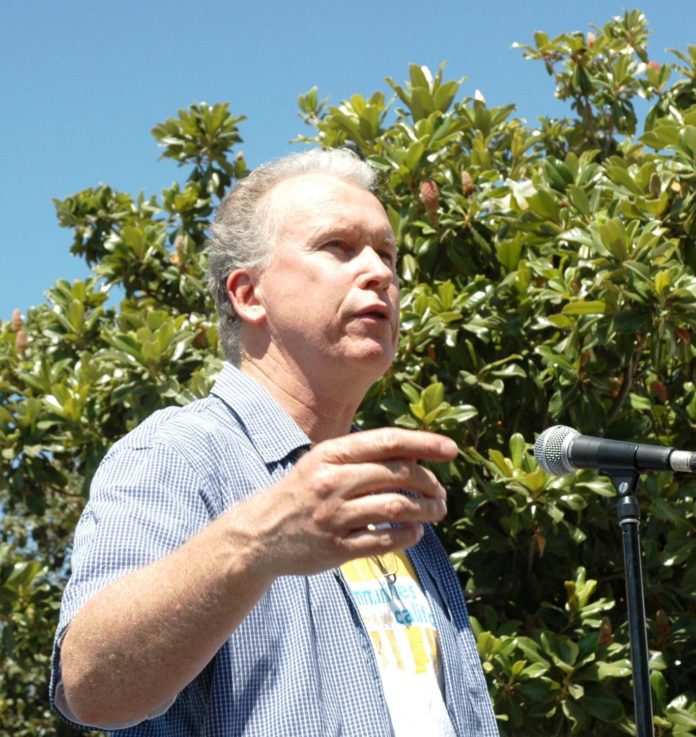
Valley Air Board’s Insensitivity
By Kevin Hall
According to the San Joaquin Valley Air Pollution Control District, it was an orange flag day on a Thursday afternoon in late September, “unhealthy for sensitive groups,” but as members of a girls’ water polo team entered the pool, they knew the air pollution was much worse—“in the purple” as one young athlete later told her mother. So when one of their teammates was stricken with an asthma attack halfway through the match, it came as little surprise. Despite the obvious risks, the game continued.
Across town at a high school in a low-income neighborhood, a pair of junior varsity football teams warmed up as the air pollution climbed high into the “red” zone. When they kicked off on schedule at 4:30 p.m. the air quality index stood at 200, “in the purple” as the kids across town put it.
The city and names of these schools really don’t matter. It could have been anywhere in the Central Valley, and the pollution causing the problems is created throughout the region. At issue is the Valley air board’s continuing failure to warn the public of high air pollution levels, health risks and impacts on people of every age.
On an orange flag day such as the one described above, there were three hours that afternoon in the red zone and two more in the purple when all outdoor activity should have stopped. While our air board members were saying, “Don’t drive, we might have to pay that $29 million fine,” what they were not saying was, “Stay indoors. It’s not safe to be outside.”
As of mid-October, this year’s 103 bad air days Valley-wide had already topped the 93 violations seen in 2010 and the 98 of 2009, and this year’s numbers would have been even higher if the air board had not agreed to removal of the Arvin-Bear Mountain Avenue monitor in Kern County.
So, what’s a public health agency to do? Why, change the numbers, of course.
The air board would like to throw out 16 days of violations recorded by two monitoring stations in Sequoia National Park in the Sierra Nevada claiming that the 6,000-acre Lion Fire in August is to blame. Their self-serving argument conveniently ignores the monitors’ 14, 15 and 19 bad air days in the preceding years (with no fires).
If successful, this move would allow the air board to continue its public spin campaign of continued progress and decreased risk, rather than one of decreased progress and continued risk.
The air board’s priorities were further reflected in its spokesperson’s comment to a Valley newspaper that “these sites are not generally representative of air quality” in the rest of the district. In other words, air pollution in the mountains just doesn’t matter. News flash to the Valley air board: The trees are dying, too, and a surprising number of people live, work and play in the Sierra.
“By every standard, this has been one of the unhealthiest Septembers in recent years,” according to Kern County resident Tom Frantz of the Association of Irritated Residents. “Unfortunately, we’re also seeing high particulate pollution in the mornings. People’s lungs are getting clogged in the mornings by particulates and burned in the afternoons by ozone. The air board should be considering these cumulative impacts during this especially dangerous time of year and calling for extra caution.”
Purple Haze
Follow this link (www.youtube.com/watch?v=9ReEudSsL2M&feature=youtu.be) to watch Frantz’s video of air pollution monitor readings during the Valley’s “purple haze” of bad air days in September. The purple zone equates to 200+ on the air quality index. Get above 100 and you really don’t want to be outside. Each square on the chart represents an hour. Count the hours above 100, 150 and 200 to see days with five or more hours in the red and purple zones.
*****
Kevin Hall is director of the Central Valley Air Quality Coalition based in Fresno, online at www.calcleanair.org and on Facebook. CVAQ is a partnership of more than 70 community, medical, public health, environmental and environmental justice organizations representing thousands of residents in the San Joaquin Valley unified in their commitment to improve the health of Californians. Contact Kevin at kevin@calcleanair.org.
